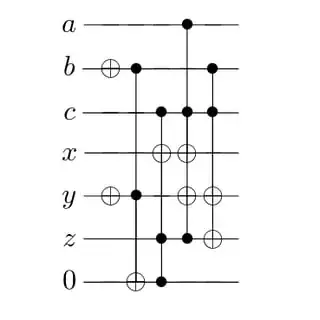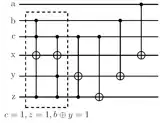
I have a certain transformations that goes as follows: Given $A=|abc\rangle$, $B=|xyz\rangle$, now I have cases as:
$$\text{if }c=1,z=1, b\oplus y=1 \implies \text{flip}(x)$$ $$\text{if }c=1, z=1 \implies \text{flip}(y)$$ $$\text{if }c=1\implies \text{flip}(z)$$ $$\text{if }b=1\implies \text{flip}(y)$$ $$\text{if }a=1\implies \text{flip}(x)$$
Can somebody just tell me the circuit for the bit-wise XOR that I have used between $b$ and $y$, i.e $b\oplus y=1$? The other gates I know are CNOT and Toffoli.
